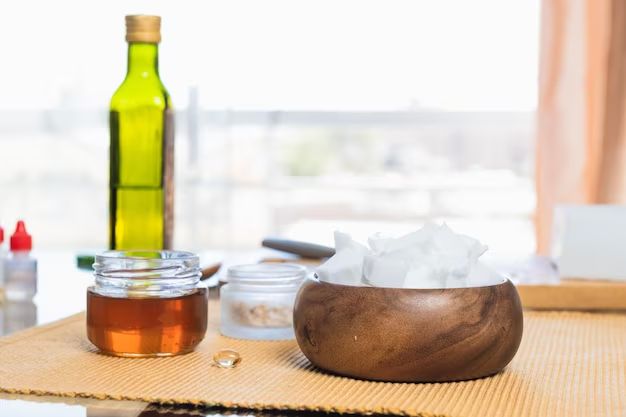When it comes to choosing an oil for a wooden bowl, there are a few key factors to consider. The main goal is to seal and protect the wood while enhancing its natural beauty. Some key aspects to think about are: the desired finish, wood type, food safety, ease of application, and maintenance needs.
Page Contents
Quick Overview
In most cases, edible oils like mineral oil, walnut oil, or olive oil work best for wooden bowls. They provide a safe, natural seal and require minimal maintenance. Oils like tung or linseed oil provide more durability but need more upkeep. Ultimately the oil choice depends on the specific bowl use and desired outcome.
What Type of Finish Do You Want?
Oils create different finishes on wood, so think about the look you want to achieve. Here are some common options:
- Penetrating or Natural Finish – Oils like mineral oil soak into the wood while allowing the natural color and grain to show through. This gives a soft, simple look.
- Protective Finish – Oils like tung oil or linseed oil create a hard, glossy coating on the surface. This gives more vibrancy and sheen.
- Stained or Tinted Finish – Some oils can be mixed with stains or dyes to alter the color. This allows for more creative, customized looks.
Consider the Wood Type
Certain oils work better with different wood species based on aspects like grain density and porosity. Here are some common wood types used for bowls and compatible oils:
| Wood | Best Oils |
|---|---|
| Maple | Tung, Walnut, Mineral |
| Cherry | Tung, Walnut, Olive |
| Walnut | Tung, Walnut, Mineral |
| Oak | Tung, Linseed, Mineral |
The wood grain density affects absorption. Open-grained woods like oak are more absorbent than closed-grain maple or cherry. Test oils first, as the optimal type can vary.
Choose a Food-Safe Oil
If the bowl will contact food, use an edible oil safe for food prep. Here are common food-safe bowl oils:
- Mineral Oil – Extracted from petroleum, mineral oil is tasteless, odorless, and won’t go rancid.
- Walnut Oil – Pressed from walnuts, this oil has mild nutty flavor perfect for bowls.
- Olive Oil – Pressed from olives, this popular oil can season and protect wood.
- Beeswax – A natural wax made by honey bees, this finishes and protects wood.
- Coconut Oil – Extracted from coconuts, this solid oil adds a light tropical aroma.
Avoid non-edible oils like tung, linseed, or sunflower oil which can leach chemicals with food contact.
Consider Ease of Application
Some oils are easier to apply than others based on viscosity. Thinner oils like mineral or walnut oil soak in quickly with simple rags or paper towels. Thicker oils like tung or linseed require more rubbing to penetrate. Beeswax needs heat to liquefy before rubbing into the wood. Consider your patience level for the oiling process when choosing a finish.
Factor in Maintenance Needs
Re-oiling frequency varies based on use and oil type. Here are general guidelines on maintenance needs:
| Oil | Maintenance Needs |
|---|---|
| Mineral Oil | Re-oil every 1-3 months with heavy use |
| Walnut Oil | Re-oil every 3-6 months |
| Olive Oil | Re-oil every 6-12 months |
| Tung Oil | Re-oil every 2-5 years |
| Linseed Oil | Re-oil every 1-3 years |
Penetrating oils like mineral or walnut require more frequent re-oiling than surface oils like tung or linseed. Consider how often you want to maintain the finish.
Best Oils for Wooden Bowl Uses
Here are top oil recommendations based on common wooden bowl uses:
Salad Bowls
- Walnut Oil – Food-safe oil that seasons and protects wood.
- Mineral Oil – Won’t go rancid and resists water marks.
- Olive Oil – Enhances flavor of vegetables and greens.
Serving and Display Bowls
- Beeswax – Safe protectant that lets wood grains shine.
- Walnut or Linseed Oil – Durable protection with sheen.
- Mineral Oil – Simple matte look maintains natural appearance.
Prep and Mixing Bowls
- Mineral Oil – Food-safe and resistant to ingredients/liquids.
- Walnut Oil – Holds up to peeling, chopping, mixing.
- Olive Oil – Repels stains and adds subtle flavor.
How to Apply Bowl Oil
Oiling a wood bowl properly ensures the finish lasts. Follow these steps:
- Lightly sand the bowl using 220+ grit sandpaper to smooth the surface.
- Wipe away all wood dust with a clean rag.
- Apply a thin layer of oil over all surfaces with a rag or paper towel.
- Let sit for 10-15 minutes so the oil can fully penetrate.
- Wipe away any excess oil with a clean rag.
- Allow to cure for 24-48 hours.
- Repeat for 3-5 coats until you achieve the desired finish.
Always check that the previous coat fully absorbed before adding more layers. For thicker oils like tung oil or beeswax, rubbing the oil vigorously helps it penetrate deep into the wood.
Oil Finishing Tips
- Work in a well-ventilated area – some oils can emit strong fumes.
- Properly dispose of oily rags to prevent fire hazards as they can self-combust.
- Try oil finishes on wood test scraps first to ensure desired results.
- Read oil labels for any specific application or curing instructions.
- Consider a matte varnish over oil for added water and stain resistance.
Conclusion
Choosing the ideal wood bowl oil involves considering factors like the desired finish, wood type, food safety needs, ease of use, and maintenance. Food-safe penetrating oils like mineral, walnut, olive, and coconut provide a safe, low-maintenance seal on most wood bowls. Harder oils like tung or linseed give added protection at the expense of more upkeep. Test different oils first to find the right fit for your specific bowl and its intended use.
